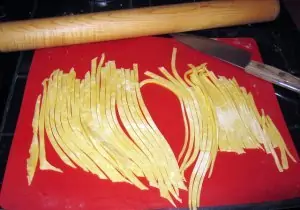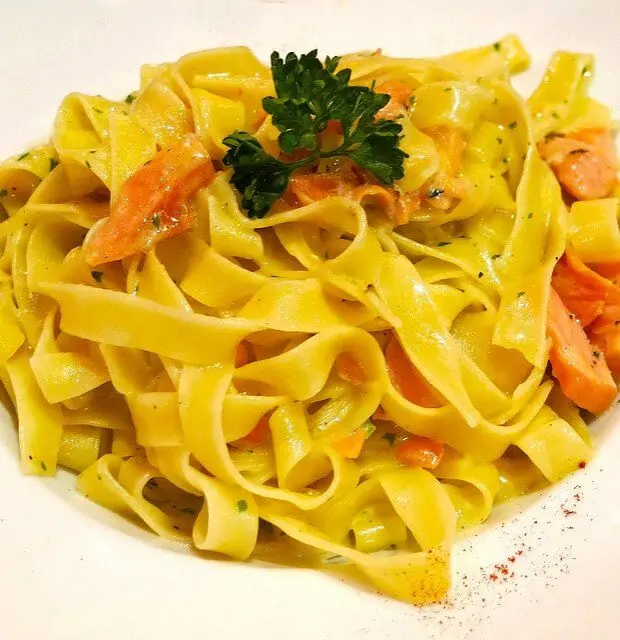
Pasta is one of those staple products that you might not think much about. Particularly when it comes to homemade noodle dishes, you probably just open a box from your pantry and throw the contents in a pot of water. Boil a pot of water in a few minutes and presto, dinner.
I’m all about convenience. I have a busy schedule, and you do, too. That you can make simple dishes, such as spaghetti, in minutes is part of the appeal of boxed pasta. After all, who has the time to make noodles?
As it turns out, you do!
Pasta: why the fear?
Making homemade pasta can seem as intimidating as baking bread at home. These are forgotten arts amongst us modern urban and suburbanites, who are used to buying these products pre-made and pre-sliced. Prior to getting deep into cooking, I saw pasta as something that you buy rather than make yourself. If no one but restaurant chefs make it themselves, it must be kind of a pain, right?
The truth is, it isn’t!
For a staple food that basically only contains flour, water, and usually egg (sometimes olive oil) why are we so intimidated by it? The idea that you can only get decent pasta from an Italian restaurant, or indeed Italy itself, seems unbelievable, and frankly, I don’t believe it. Something’s fishy, and it isn’t a creamy pasta dish topped with the best smoked salmon that you made at your last BBQ!
I suspect the reason comes down to marketing. Just as bread companies aren’t going to try to persuade you to bake your own bread, pasta manufacturers would rather sell their product to you, too. Somehow, they’ve made it feel like you can’t do it yourself.
Time to pull back the noodley veil and see what really goes into making pasta.
Why should I make my own pasta?

It’s hard to find time to cook, but it’s always worth the effort. You know I like keeping things simple, but I also think developing the skills needed to cook staples like pasta at home are good for the soul. It connects us to our food, our family, and our bodies.
Making your own pasta is fast, fun, and quite cheap. Quality noodles can be quite pricey, but the ingredients to make fresh, delicious pasta at home are probably already in your cupboard.
Not only do you save money, but you also control exactly what goes into your noodles. Use your favorite organic flours, like buckwheat, or add pureed spinach for a dose of healthy veg!
Plus, it requires so little effort, you can make noodles while watching Netflix or listening to your kitchen radio.
How to make pasta at home
There are many quick and easy methods to make pasta yourself. Here is a 5-step, basic recipe that will produce great results:
- Add 1 cup of flour and 1/2 teaspoon salt to a mixing bowl.
- Add an egg and 1/2 tablespoon of olive oil.
- Whisk until well-combined.
- Turn the dough out onto flour and knead until it doesn’t stick.
- Let rest.
Seriously, that’s pretty much it. It’s so simple, you’ll wonder why you hadn’t tried it before!
Rolling your dough
This is where the fun starts—queue up your favorite Netflix web series and roll up those sleeves! Now that you have your dough, you have a lot of options to choose from when it comes to shapes and sizes. Are you making fettuccine, lasagna, or ravioli? The type of noodles you prefer may affect which rolling pin(s) you need.
For basic, long and flat noodles, roll out the dough to your desired thinness and cut into strips with a knife. I recommend laying the noodles out on a cookie sheet lined with some wax paper, spacing them a little apart so they don’t stick together.
Now just set them aside as you prepare your sauce or pesto, and prepare as usual when it’s time to cook dinner.
Recommended models
There are many different types of rolling pins, and your choice can change the final product dramatically. So, let’s look at some of the best rolling pins to do the job.
/G Tagliatelle Cutter Rolling Pin
First, we have the Tagliatelle Rolling Pin from /G. Tagliatelle is a traditional type of pasta that consists of flat ribbons, typically between 1/4 inch to 1/3 inch in width. The tagliatelle roller has strips cut into its rolling surface, which lets you uniformly roll and cut your tagliatelle.
Make your own noodles for lasagna. My favorite lasagna pans for a big group.
Beechwood Spaghetti Cutter Rolling Pin by Eppicotispai
Ready to make your own spaghetti? Like Sous Chef UK, Eppicotispai makes a variety of rolling pins for pasta. These pins are manufactured in Italy, home of many of our favorite noodles, from natural beechwood.
The one downside with these cutting pins is that the wooden edges are not as sharp as a knife. That means they require a bit of strength to use. You’ll also need to use a different pin for each type of noodle.
If you plan on making a lot of one noodle variety, and don’t mind adding a bit of elbow grease to the recipe, then the Eppicotispai pins might be for you.
New Italian Wood Ravioli Rolling Pin Pasta Mold by Norpro
Artisan pastas aren’t beyond your reach with the Italian Wood Ravioli Rolling Pin Pasta Mold from Norpo. This beechwood gadget lets you make ravioli via the indents carved into the rod. Simply roll out a sheet of dough, add your favorite fillings to each rectangle, cover with a second layer of dough, and then roll again. You’ll be well-rewarded with 1-inch homemade ravioli!
Imagine someone, a guest in your kitchen, asking, “What type of roller is that?” You can brag and say, “Oh that’s for cutting the pasta, did I mention that I make my own?” They’ll think you’re a top-notch chef, and super cool.
Adjustable Rolling Pin by Joseph Joseph
Another unique pasta roller is the Joseph Joseph (no, that is not a typo) Adjustable Rolling Pin. This nifty-looking gadget has four sets of removable disks at both ends to give you control over the thickness of your pasta. The disks will also make uniform rolls, making cutting the pasta afterward that much easier.
With the various measurements guide, etched right into the pin itself, this model is great for more than just pasta! You can also use it for pizza and pie crusts, tarts, and cookies.
Maplewood Rolling Dowel by J.K. Adams
Sometimes, you just want to keep it simple. This classic J.K. Adams 19-Inch-by-2-Inch rolling dowel is as simple as it gets. Elegant, yet performant, a rolling dowel is an excellent choice for homemade noodles. This model is handcrafted and finished in Vermont and is crafted from renewable and sustainable maple wood.
As an added bonus, the rolling pin comes with a manufacturer’s lifetime warranty. Even better, you get the quality construction you know and expect from J.K. Adams.
Frequently Asked Questions
How do you store freshly made pasta?
You can store freshly made pasta in the fridge for up to 24 hours. Remember to bring the pasta back to room temperature before cooking! If you’d like to freeze your pasta, you can store it lumped together for up to 3 months in your freezer.
You can also dry your pasta! To dry your pasta, lay the pasta over a drying rack, on coat hangers, or the back of a chair and let dry. Store in an airtight container for up to several weeks!
I’m gluten intolerant, what ingredients can I use to make my own gluten-free pasta?
Gluten-free pasta is so easy to make. Here is a recipe from Jamie Oliver that is completely gluten-free.
150 g gluten-free rice flour, plus extra for dusting
50 g potato starch
1 tablespoon corn flour
2 tablespoons xanthan gum
¼ teaspoon fine sea salt
3 large free-range eggs
1 tablespoon extra virgin olive oil
That’s it! Make your pasta just like any other pasta and enjoy.
I’m short on time, which rolling pin is the best for quickly making a batch of pasta?
You can never beat a simple and good quality rolling pin to help you save time. We love the Maple Wood Rolling Dowel by JK Adams at Amazon for a simple and easy rolling pin to roll your pasta. Just like JK Adams products in general, we love the quality and design of this rolling pin. Simplicity at it’s finest, an investment in this rolling pin will surely make you happy, and impress your family with delicious freshly made pasta!
How long does fresh pasta take to cook?
Fresh pasta takes a considerably less time to cook than dried pasta, so watch it carefully! Typically fresh pasta takes only 1-3 minutes to cook, which is great! To test to make sure your pasta is done, remove a noodle or bit of pasta and take a bite! It should taste yummy and fully cooked.
What is the simplest way to serve fresh homemade pasta?
Homemade pasta can be paired with any of your favorite sauces! You can make freshly made tomato sauce, or add pesto for a burst of flavor. Another great way to serve homemade pasta is simply with olive oil and parmesan cheese. We love this cheese grater at Amazon for high quality grated parmesan, for any pasta dish.
Conclusion
There are many great rolling pins out there, but any of these will add that little extra Italian magic to your home-made pasta experience.
Don’t be afraid of making pasta! Embrace it! Cooking is all about enjoyment and satisfaction. What could be more satisfying than rolling up your sleeves getting your hands floury? Impress not only yourself but also your friends, your family, your roommates, random strangers, who cares! Everyone loves pasta.
Image credit via Flickr Creative Commons: Karen and Brad E. and torbakhopper.









